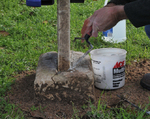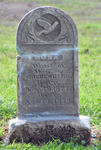
Presentations/Workshops
In the past four years, I have done several presentations to historical and genealogical organizations who were interested in my work, or who wanted some instruction for their members before starting on a cemetery cleanup in their area.
I am willing to share my knowledge and experience with your group and do cemetery walks to advise you on what can be done by trained and willing volunteers; I will also hold training/workdays with members to demonstrate "best practices" in gravestone conservation. Similarly, if you would like for me to speak to your group, I have a PowerPoint presentation of some of my jobs and can follow up afterwards with a question-and-answer session for those wanting to learn more. While some conservation work should be reserved for a skilled conservator, many simple things like cleaning and straightening can be done by properly trained volunteers.
If you are/know the supervisor of a municipal cemetery, I would be very happy to share what I know with you and your workers so that stones are not damaged and your upkeep can be streamlined.
Contact me if you would like more information on either at 979-836-7715 OR
Presentations and Workshops
- Lockhart (Caldwell Co.) April 22, 2017
- Crown Hill Cemetery (Pasadena, TX) June 10, 2017 (click here to see work and interviews on YouTube)
- Jazzy Jewels luncheon in Brenham July 12, 2017
- LaPorte Cemetery Association December 2, 2017
- Independence Cemetery Tour (10 a.m.) March 10, 2018
- Presentation and volunteer training for the Victoria Co. Historical Commission--June 2, 9am-1pm
- October 2018 meeting of the Washington Co. Genealogical Society--"Gravestones and Genealogy" (7 p.m. Blinn College Student Center)
- October 13, 2018--Crown Hill Cemetery Pasadena, TX tour--First Annual Tour of the cemetery with costumed actors relating residents' lives and experiences in early Pasadena's history.
- Walking tour of Independence Cemetery (1 p.m.) April 4, 2019 for DRT chapter. If the weather is good, I'll be around the cemetery until 4; the bluebonnets are out!
- Demonstration of Conservation Techniques at Victoria's Evergreen Cemetery June 1, 2019
- Houston Genealogical Forum--October meeting 2022
- Washington County Genealogical Society March 6, 2023
More Photos
The following photos show the process to fabricate a base for a tablet-style stone. Click on the photo to read more.
The following photos show how a tablet is mortared into a socket base. Click on photo for caption.
Conservation and Old Repairs
Repairs made to gravestones in the early 20th century vary widely. Some were done well, while others were done by individuals with more ambition than skill. Almost all methods from 100 years ago have been superceded by modern materials, tools and techniques, and sometimes the old repair can still be 'undone' to better conserve the stone.
Below are two photos of the same piece of a tablet stone. The person who repaired the stone the first time used Portland cement-based mortar as an adhesive to "glue" the two pieces together; in doing so, he did not clean the mortar from the lettering, and thus, covered it. The original repair failed and another was done later with a foaming glue which also failed. I was hired to conserve the stone, and while the stone was in my shop, I decided to carefully attempt to remove the mortar and allow the inscription to show. After four hours of work, the mortar was removed with no harm to the stone or the lettering.
This is the stone after it was reset in the cemetery and cleaned with D/2.
Some may ask why was the verse at the bottom not re-carved. As a conservator, my job is to preserve and protect the marker, not restore it to its original appearence.
As the stone did not have a socket base originally, it was reset into a bed of crushed rock and surrounded by the same; this will promote quicker drying and prevent ground moisture from wicking upwards through the stone.


































